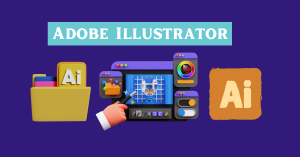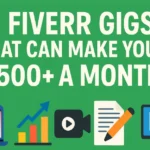In the dynamic realm of graphic design, industry giants like Adobe’s Photoshop and Illustrator continue to reign supreme, offering a comprehensive suite of tools for creating and editing digital art. Canva stands out as a user-friendly solution, accessible to multitudes, making design an intuitive journey.
Figma emerges as a collaborative design tool, reshaping the way website and app interface designs come to life. Amidst recent tools that redefine design possibilities, my personal experience intertwines with these programs, crafting a symphony of creativity in the ever-evolving world of graphic design.
Table of Contents
ToggleAdobe Illustrator

Adobe Illustrator stands as a hallmark in the realm of vector graphics software. Its robust suite of features caters to diverse design needs, making it a go-to choice for creating professionally designed logos, captivating artwork, intricate infographics, and pixel-perfect icons. Unleashing the power of AI, Adobe Illustrator introduces the groundbreaking Generative Recolor tool, opening doors to limitless colour palettes and dynamic themes.
User-Friendly Experience and Flexible Subscription Plans
This graphic design powerhouse offers a seamless experience, enabling users to effortlessly navigate through the intricacies of design. The seven-day free trial is a tempting gateway, ensuring users can explore its potential without the burden of providing credit card information. The subscription plans, be it the annual plan at $20.99 per month or the monthly plan at $31.49, grant access to a plethora of functionalities.
Advanced Capabilities: Easier Tracing and Font Identification
Delving into its capabilities, the Image Trace feature is a game-changer, effortlessly auto-detecting and adapting to any specific kind of art. The ability to swiftly remove image colouring while reducing anchor points simplifies the process of easier tracing. A unique feature, Retype, allows users to identify unknown fonts from an artwork and use them instantly in their designs.
Seamless Collaboration and Export Options
For designers keen on seamless collaboration and export, Adobe Illustrator offers an array of options. Artwork export seamlessly translates designs into the desired format, including the modern WebP image for optimised website and app usage. Hand lettering enthusiasts can digitise their freehand fonts with precision.
Integration and Versatility
Integration is where Adobe Illustrator truly shines. The software seamlessly integrates with other editing tools within the Adobe family, providing a cohesive design environment. Whether you start from scratch or choose from a vast array of templates, the software ensures a smooth journey. Its wide range of vector design tools underscores its versatility in catering to various graphic design creations.
Considerations: Resource-Heavy Nature and Learning Curve
However, it’s essential to note that Adobe Illustrator can be resource-heavy and comes with expensive subscription plans. The learning curve might be steep for beginners, and complex file management can pose challenges. While it excels in vector design, its limited photo editing capabilities might prompt users to explore additional tools for comprehensive projects.
In conclusion, Adobe Illustrator remains an industry leader, weaving a tapestry of creativity with its extensive toolset and innovative features. Whether you’re a seasoned designer or just developing your skills, this software continues to be a stalwart companion on the creative journey.
Adobe Photoshop
In the dynamic realm of graphic design, Adobe Photoshop reigns supreme as the premier choice, offering a comprehensive suite of tools for photo editing and manipulation. Its broad range of applications encompasses digital art and image refinement, making it an indispensable resource. What sets Adobe Photoshop apart is its unrivalled nondestructive editing capabilities, akin to those found in Illustrator, providing graphic designers with the precision and versatility needed to bring their creative visions to life.
The software’s extensive features tap into the depths of imagination, utilising advanced algorithms to enhance the quality of designs. The recent integration of Artificial Intelligence is exemplified by tools like Adobe Firefly and Generative Fill with the Expand feature, ushering in a new era of functionality.
This infusion of AI proves advantageous for graphic designers, reducing reliance on stock photos and mitigating potential copyright concerns. Designers can now effortlessly select a portion of an image with one simple prompt, generating stunning additions and enhancing specific elements with ease.
For photographers and social media influencers, Adobe Photoshop’s powerful AI-driven tools offer exceptional capabilities for background removal and image enhancement. The software’s prowess in portrait retouching is unparalleled, empowering professionals to anticipate and revolutionise their industry.
The recent integration of AI is a game-changer, providing graphic designers with a unique set of tools to elevate their work. The reliance on stock photos diminishes as designers leverage the capabilities of Adobe Photoshop, using text prompts and innovative features to craft visually striking designs.
In this ever-evolving landscape, Adobe Photoshop stands as a reliable and indispensable companion for those who seek precision, creativity, and efficiency in their graphic design endeavours.
CorelDraw Graphics Suite
In the dynamic realm of graphic design, CorelDRAW Graphics Suite emerges as a versatile and full-featured solution, providing a comprehensive suite of tools for both digital and print designs. With a focus on vector illustration, the software caters to the diverse needs of professionals and beginners alike, offering a user-friendly environment for creating intricate designs and dynamic page layouts.
Its powerful features span various computer platforms, including Windows, Mac, Web, and iPad through the innovative CorelDRAW.app, facilitating real-time collaboration with clients and team members.
As a formidable rival to Adobe Illustrator, CorelDRAW Graphics Suite ignites innovation in the industry. Its extensive file format support, including compatibility with the WEBP file format, establishes it as an industry standard for image optimization on the web. Professionals benefit from its versatile file support, making it an ideal choice for collaborating with vendors and fellow designers.
The suite’s specialised features, such as advanced typography tools and seamless integration with Google Fonts, add an extra layer of sophistication to graphic design projects. This makes CorelDRAW Graphics Suite the preferred choice for web designers, print professionals, and small business owners, offering a powerful and comprehensive set of tools to enhance every creative endeavour.
GIMP
In the dynamic landscape of graphic design software, GIMP emerges as a standout choice for Linux-based operating system users, offering a free and open-source solution on major platforms like Windows and Mac OS. Its comprehensive range of features encompasses photo editing and 2D art creation tools, rivalling even Adobe’s offerings.
This lightweight and resource-efficient tool excels in tasks such as photo manipulation, with robust support for RGB, raster graphics, and native CMYK. Key features like customizable docking interface, Script-Fu scripting, GEGL integration, and a free plugin ecosystem enhance its versatility.
GIMP facilitates a wide range of file type support, enabling seamless exporting of images, vectors, and documents in formats such as jpg, jpeg, HTML, HEIC, and PDF. The software’s flexibility extends beyond designing, ensuring easy collaboration and sharing of work across diverse vendors, making it an ideal choice for budget-conscious graphic designers, photographers, and digital artists.
While it may lack some polished features found in paid alternatives like Adobe Photoshop, GIMP stands as a powerful, cost-effective solution, addressing the editing needs of those embarking on their creative journey.
Pixlr
In the dynamic world of graphic design, Pixlr stands out as a web-oriented solution with a unique platform-neutral focus. This approach ensures that its robust suite of editing tools is easily accessible across devices through any modern web browser. Pixlr’s versatility is evident in its user-friendly design, catering to everyone from beginners to seasoned professionals.
Pixlr goes beyond conventional editing by seamlessly combining fundamental photo manipulation with an innovative AI-driven tool. This tool introduces an AI-created image feature that not only streamlines the result generation but also allows for creative refinement based on user input. The inclusion of diverse backgrounds adds an extra layer of creativity to the editing process.
One of Pixar’s standout features is its broad user appeal. Whether you’re a social media manager in need of quick edits, a casual user exploring basic to moderate photo editing capabilities like cropping and filters, or a professional handling complex projects, Pixlr caters to all.
With comprehensive photo editing and manipulation tools, support for major file types like PSD, and an integrated stock library, Pixlr positions itself as a serious competitor alongside industry giants like Adobe Photoshop and Affinity Photo. Its simplicity and web-based nature make graphic design an accessible art form for all, ushering in a new era of limitless creativity.
Figma
In the realm of graphic design, Figma stands out as a top-notch tool, offering an intuitive interface that seamlessly integrates with web and app design. Its prototyping capabilities provide designers with a versatile platform for creating interactive and dynamic user interfaces.
Figma’s strengths extend beyond design; it fosters a robust community, providing valuable resources such as UI Kits that streamline the creative process. The software’s efficiency in migrating design elements is evident through the generation of CSS code, ensuring a smooth transition from concept to implementation.
At the core of Figma’s appeal is its cloud-first design approach, promoting offline design accessibility for uninterrupted workflow. The software’s commitment to real-time collaboration features establishes a centralised design system, reducing the likelihood of errors and promoting design consistency.
Figma is a true lifesaver for designers and product teams, offering a one-stop-shop for creating, revising, and implementing designs. Its dynamic features make it an indispensable tool for collaborative creatives, aligning seamlessly with the ever-evolving landscape of graphic design.
canva
In the dynamic landscape of graphic design software, Canva shines as a user-friendly platform, catering to a broad audience, including social media influencers, students, and everyday computer users. Its easy drag-and-drop feature simplifies the design process, allowing users to create attention-grabbing content effortlessly.
The extensive template library, offering trendy templates for social media posts, stylish presentations, and more, makes Canva an indispensable tool for diverse needs.
Canva’s commitment to providing a quick and easy design solution is evident in its AI-driven features, such as background removal and image enhancement, ensuring not only unique but also visually appealing designs. With a free plan option and premium templates, Canva offers flexibility and becomes a worthwhile investment for those seeking professional and attractive designs.
Whether crafting marketing materials or personalising a resume, Canva emerges as an excellent tool, simplifying the design process and meeting the day-to-day needs of a wide range of users, from seasoned designers to beginners and small business owners.
Inkscape
In the realm of graphic design tools in 2024, Inkscape stands out as a cost-effective, versatile choice for designers, illustrators, and hobbyists alike. This free, open-source software offers an intuitive interface, comprehensive drawing tools, and advanced capabilities such as path operations and node editing.
Inkscape’s calligraphy tools, customizable settings, and support for live linked clones and patterns bring an interesting and personalised touch to the design process. While it may be slower than some premium options, Inkscape’s no-cost alternative status makes it an attractive choice for those on a budget.
Compatible with various operating systems and vector file formats, Inkscape excels in creating scalable vector graphics, from simple shapes to intricate designs. Its features cater to a wide range of creative needs, providing a robust set of capabilities for crafting detailed vector designs with a classic writing feel for graphic tablet users.
Procreate
Procreate, a revolutionary graphic design software, stands out as a comprehensive art studio designed for iPad users, boasting seamless Apple Pencil support. Priced affordably at $12.99 with a one-time purchase option, Procreate redefines the design tools landscape with its advanced features, including 3-D painting and state-of-the-art brush control, giving it a competitive edge over rivals.
This software allows users to work in 3D, providing real-time previews, even in augmented reality (AR). With a diverse set of editing tools, encompassing 200 customizable brushes, intuitive selection, and the ColorDrop tool, Procreate excels in colour management and enhances overall efficiency.
Despite its lack of a free version and some limitations in layering, Procreate compensates with its user-friendly interface, hover features, and a responsive brush cursor, making it an indispensable asset for graphic designers seeking a dynamic and immersive creative experience exclusively on the iPad platform.
As someone deeply engaged in graphic design, Procreate has consistently proven to be an invaluable companion, offering a seamless avenue for translating creative visions into captivating digital art.In the dynamic landscape of graphic design tools in 2024, one standout option is Sketch. As a Mac-only vector editing software, its customizable interface and seamless workflow make it a preferred choice for both beginners and seasoned designers.
The software’s functionality encompasses a photo editor, addressing diverse design needs, from web design to mobile interfaces. Despite its Mac exclusivity, Sketch offers a 30-day trial and a free tier, making it accessible for individuals and businesses alike. The community support is robust, providing solutions and collaboration features that benefit freelancers and temporary project needs.
From its uncluttered interface to the version comparison feature, Sketch simplifies design processes while acknowledging its limitations, such as the expensive subscription model. In my experience, Sketch has proven invaluable, aligning seamlessly with my design workflow and preferences.
Conclusion
In conclusion, the graphic design landscape in 2024 boasts a diverse array of powerful tools catering to the needs of designers across various skill levels and preferences. Industry stalwarts like Adobe Illustrator and Photoshop continue to set the standard with their robust features and AI integrations, offering unparalleled precision and versatility.
CorelDRAW Graphics Suite emerges as a formidable competitor, providing a comprehensive solution for both digital and print designs. Free and open-source options like GIMP and Inkscape cater to budget-conscious designers, showcasing their capabilities in photo editing and vector graphics.
Figma stands out for its collaborative design approach and seamless integration with web and app design. Canva’s user-friendly platform, Pixlr’s web-oriented focus, and Procreate’s revolutionary features for iPad users add unique dimensions to the graphic design toolkit. Sketch, with its Mac exclusivity, offers a streamlined workflow and customization options.
As we navigate the ever-evolving world of graphic design, these tools collectively contribute to a vibrant and dynamic creative landscape, empowering designers to bring their visions to life with efficiency and innovation.
FAQs
Which software is best for graphic designing?
More videos on YouTube
- Adobe Illustrator. Adobe Illustrator is the best graphic design software for vector graphics design and has been for a while
- Adobe Photoshop
- CorelDraw Graphics Suite
- Adobe InDesign
- GIMP
Where will graphic design be in 10 years?
As digital platforms expand, augmented reality becomes mainstream, and artificial intelligence advances, graphic designers will find themselves at the forefront of creating captivating visual experiences
Who is No 1 graphics designer?
Milton Glaser is one of the most successful graphic designers in the world.
How will graphic design be used in the future?
Growing fields of graphic design. The future of graphic design involves not only how attractive a digital space looks, but also how functional it is. This is known as user experience (UX) or UX-focused graphic design, and it’s critical for webpages to be user-friendly, navigable and accessible
What are graphic tools?
Graphic design tools are programs or software that can help graphic designers complete their work. These online tools can allow a designer to efficiently brainstorm, create, edit and share their designs with clients. The scope, functionality and availability of tools can vary.





